Related Research Articles

This page lists some links to ancient philosophy, namely philosophical thought extending as far as early post-classical history.

The history of China has taken place over several millennia across a wide geographical area. The notion of 'China' can be understood under many diverse historiographical, cultural, geographic, and political lenses, and has evolved tremendously over time. Each region now understood to be part of the Chinese world has alternated between many periods of unity, fracture, prosperity and hardship. Classical Chinese civilization first emerged in the Yellow River valley, and it with the Yangtze and Pearl valleys now constitute the geographic core of China and have for the majority of its imperial history. China maintains a rich diversity of ethnic and linguistic people groups. The traditional lens for viewing Chinese history is the dynastic cycle: imperial dynasties rise and fall, and are ascribed certain achievements. Throughout pervades the narrative that Chinese civilization can be traced as an unbroken thread many thousands of years into the past, making it one of the cradles of civilization. At various times, states representative of a dominant Chinese culture have directly controlled areas stretching as far west as the Tian Shan, the Tarim Basin, and the Himalayas, as far north as the Sayan Mountains, and as far south as the delta of the Red River.

Chinese philosophy originates in the Spring and Autumn period (春秋) and Warring States period (戰國時期), during a period known as the "Hundred Schools of Thought", which was characterized by significant intellectual and cultural developments. Although much of Chinese philosophy begun in the Warring States period, elements of Chinese philosophy have existed for several thousand years. Some can be found in the I Ching, an ancient compendium of divination, which dates back to at least 672 BCE.

Taoism or Daoism refers to a set of Chinese traditions and religions which emphasize living in harmony with the Tao. The Tao is generally defined as the source of everything and the ultimate principle underlying reality. The Tao Te Ching and the Zhuangzi are widely considered key Taoist texts.
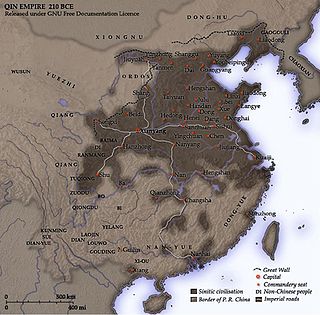
The Qin dynasty, or Ch'indynasty, was the first dynasty of Imperial China. Named for its heartland in Qin state, the Qin dynasty arose as a fief of the Western Zhou and endured for over five centuries until 221 BC when it was briefly elevated to an empire, which lasted only until 206 BC. It was established in 221 BC when Ying Zheng, who had already been king of Qin since 246 BC, declared himself the First Emperor.
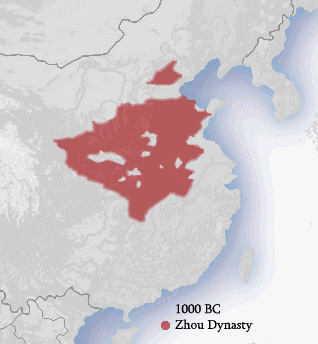
The Zhou dynasty was a royal dynasty of China that followed the Shang dynasty. Having lasted 789 years, the Zhou dynasty was the longest dynastic regime in Chinese history. The military control of ancient China by the royal house, surnamed Ji, lasted from 1046 until 771 BC for a period known as the Western Zhou, and the political sphere of influence it created continued well into the Eastern Zhou period for another 500 years. The establishment date of 1046 BC is supported by the Xia–Shang–Zhou Chronology Project and David Pankenier, but David Nivison and Edward L. Shaughnessy date the establishment to 1045 BC.

The Five Dynasties and Ten Kingdoms period was an era of political upheaval and division from 907 to 979. Five dynastic states quickly succeeded one another in the Central Plain, and more than a dozen concurrent dynastic states, collectively known as the Ten Kingdoms, were established elsewhere, mainly in South China. It was a prolonged period of multiple political divisions in Chinese imperial history.
Eastern philosophy or Asian philosophy includes the various philosophies that originated in East and South Asia, including Chinese philosophy, Japanese philosophy, Korean philosophy, and Vietnamese philosophy; which are dominant in East Asia, and Indian philosophy, which are dominant in South Asia, Southeast Asia, Tibet, and Mongolia.

Chinese culture is one of the world's oldest cultures, originating thousands of years ago. The culture prevails across a large geographical region in East Asia with Sinosphere in whole and is extremely diverse, with customs and traditions varying greatly between provinces, cities, and even towns. The terms 'China' and the geographical landmass of 'China' have shifted across the centuries, with the last name being the Great Qing, before the name 'China' became commonplace in modernity.
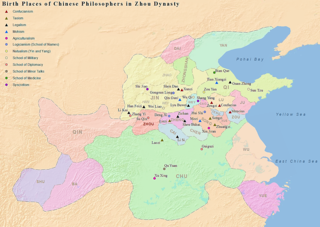
The Hundred Schools of Thought were philosophies and schools that flourished from the 6th century BC to 221 BC during the late Spring and Autumn period and the Warring States period of ancient China.

The Xin dynasty, also known as Xin Mang in Chinese historiography, was a short-lived Chinese imperial dynasty which lasted from 9 to 23 AD, established by the Han dynasty consort kin Wang Mang, who usurped the throne of the Emperor Ping of Han and the infant "crown prince" Liu Ying. The Xin dynasty ruled for over a decade before it was overthrown by rebels. After Wang's death, the Han dynasty was restored by Liu Xiu, a distant descendant of the Emperor Jing of Han; therefore, the Xin dynasty is often considered an interregnum period of the Han dynasty, dividing it into the Western Han and the Eastern Han.
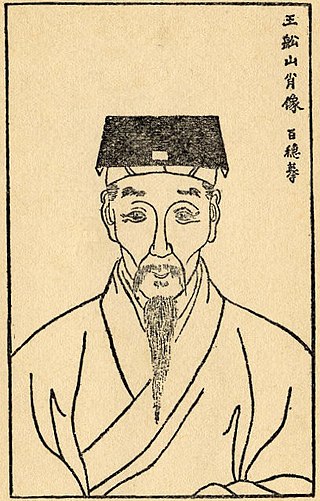
Wang Fuzhi (Chinese: 王夫之; pinyin: Wáng Fūzhī; Wade–Giles: Wang2 Fu1-chih1; 1619–1692), courtesy name Ernong (而農), pseudonym Chuanshan (船山), was a Chinese essayist, historian, and philosopher of the late Ming, early Qing dynasties.

Philosophy is the systematized study of general and fundamental questions, such as those concerning existence, reason, knowledge, values, mind, and language. Some sources claim the term was coined by Pythagoras, although this theory is disputed by some. Philosophical methods include questioning, critical discussion, rational argument, and systematic presentation.

Zhengyi Dao, also known as the Way of Orthodox Unity, Teaching of the Orthodox Unity, and Branch of the Orthodox Unity is a Chinese Taoist movement that traditionally refers to the same Taoist lineage as the Way of the Five Pecks of Rice and Way of the Celestial Masters, but in the period of the Tang dynasty and its history thereafter. Like the Way of Celestial Masters, the leader of Zhengyi Taoism was known as the Celestial Master.
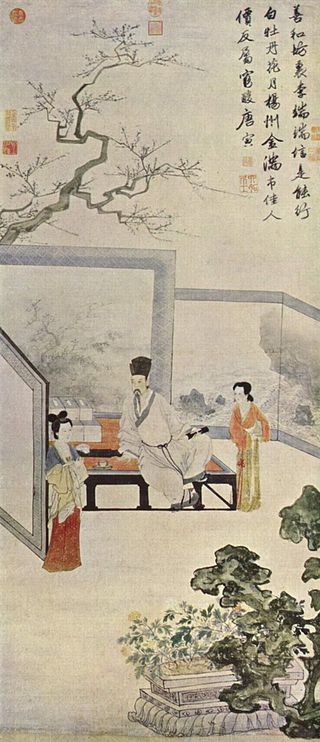
The four occupations, or "four categories of the people", was an occupation classification used in ancient China by either Confucian or Legalist scholars as far back as the late Zhou dynasty and is considered a central part of the fengjian social structure. These were the shi, the nong, the gong, and the shang . The four occupations were not always arranged in this order. The four categories were not socioeconomic classes; wealth and standing did not correspond to these categories, nor were they hereditary.

East Asia is the easternmost region of Asia, which is defined in both geographical and ethno-cultural terms. The modern states of East Asia include China, Japan, Mongolia, North Korea, South Korea, and Taiwan. Hong Kong and Macau, two small coastal quasi-dependent territories located in the south of China, are officially highly autonomous but are under Chinese sovereignty. Japan, Taiwan, South Korea, Mainland China, Hong Kong, and Macau are some of the world's largest and most prosperous economies. East Asia borders Siberia and the Russian Far East to the north, Southeast Asia to the south, South Asia to the southwest, and Central Asia to the west. To the east is the Pacific Ocean and to the southeast is Micronesia. Some people include Vietnam—a Southeast Asian country geographically—as part of East Asia, as it is always considered part of the East Asian culture sphere.

Myōken, also known as Sonjō-Ō, is a Buddhist deification of the North Star worshiped mainly in the Shingon, Tendai and Nichiren schools of Japanese Buddhism.
The New Qing History is a historiographical school that gained prominence in the United States in the mid-1990s by offering a wide-ranging revision of history of the Manchu-led Qing dynasty of China. Orthodox historians tend to emphasize the power of the Han people to "sinicize" their conquerors in their thought and institutions. In the 1980s and early 1990s, American scholars began to learn Manchu and took advantage of newly opened Chinese- and Manchu-language archives. This research found that the Manchu rulers were savvy in manipulating their subjects and from the 1630s through at least the 18th century, emperors developed a sense of Manchu identity and used traditional Han Chinese culture and Confucian models to rule, while blending with models from other ethnic groups across the vast empire, including those from northern China, the Eurasian Steppe, Inner Asia, and Central Asia. According to some scholars, at the height of their power, the Qing regarded the Han Chinese as only a part, although a very important part, of a much wider empire that extended into the Inner Asian territories of Mongolia, Tibet, Manchuria and Xinjiang.

Middle Eastern philosophy includes the various philosophies of the Middle East regions, including the Fertile Crescent and Iran. Traditions include Ancient Egyptian philosophy, Babylonian philosophy, Jewish philosophy, Iranian/Persian philosophy, and Islamic philosophy.
Taoist philosophy also known as Taology refers to the various philosophical currents of Taoism, a tradition of Chinese origin which emphasizes living in harmony with the Dào. The Dào is a mysterious and deep principle that is the source, pattern and substance of the entire universe.
References
- ↑ Carr, Brian; Carr, Brian; Mahalingam, Indira, eds. (1997). Companion Encyclopaedia of Asian Philosophy. Routledge Companion Encyclopaedias (1st ed.). Routledge. p. 466. ISBN 9780415035354.